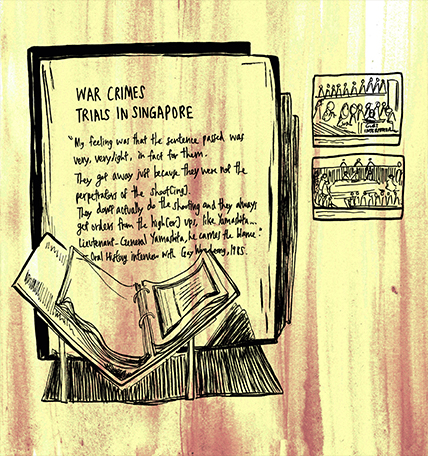Learning a new language, especially during wartime when one has to fend for one’s own life, is not an easy feat. For Simone Marie Besançon, she had to learn Japanese in complete secret, when she was interned by the Japanese during their occupation in Java. This was because as a Frenchwoman, the Japanese did not want her to learn their language and understand what they were planning to do.
Her multilingualism did not stop there. Mdm Besançon was born in Belgium near the French border, and educated in Paris. She also met her husband during a round-the-world trip: A Dutch naval officer, Lieutenant-Commander Besançon in Java, whose ship eventually went down fighting a Japanese convoy in the China Sea. Being an intelligent woman, her multitude of experiences in different places and dynamic interaction with people of different nationalities gave Mdm Besançon the background for a strong proficiency in French, Dutch and English as well.
Her linguistic proficiency turned out to be an exceptionally useful skill, especially when it came to serving due justice during the war crime trials. Upon finding out that she could speak Japanese, the Allies flew Mdm Besançon to Singapore to aid with the Singapore war crimes trials as a Japanese interpreter. It was in Singapore where she further developed her aptitude in the languages by learning Malay, and even tried developing mastery over Mandarin by attending a Singapore Mandarin school.
Acting in her capacity as a Japanese interpreter was especially pivotal. Mdm Besançon lived in Raffles Hotel and served as the interpreter of the No. 7 War Crimes Investigation Team. Through this, she helped to bring to book Japanese war crimes suspects in Changi Gaol by translating Japanese language statements into English. As an interpreter, she was generally called upon to interpret in the questioning of Japanese war crimes suspects in Changi, and was heavily involved in preparing the statements of the accused, as well as witnesses in the Singapore war crimes trials. Such statements were rudimental for the purposes of legal evidence, especially because the Japanese had destroyed most documentary evidence after the war, leaving limited sources of legal evidence to produce before the Courts. For example, one of the cases dealt with by Mdm Besançon involved 5 Japanese soldiers in the killings of two innocent Malay policemen along Ramgsang Island, where heavy corroboration between the different statements of the accused was important in determining whether there was a conference plotting the murder of the victims, as well as whether the killings were done as a spur of the moment as a means of self defence.
The significance of statements as a source of legal evidence also meant that Mdm Besançon’s involvement in trials was important. Beyond acting as an interpreter, Mdm Besançon also acted as a witness and testified in numerous trials about her work as an interpreter. This was even though women in her time were rarely called upon to interpret at trials involving Japanese war crimes suspects, due to the belief that such trial participation would be more taxing on women than men.
It was critical that Mdm Besançon testified in the trials she acted as an interpreter for, because the documents she handled were often tendered as evidence against the accused over the course of the trial process. It was therefore crucial that Mdm Besançon complied with procedural rules during the interpretation process, when statements were made by the accused, and that her transcripts were true and accurate. This was to ensure that the accused were mindful of the potential ramifications that may follow their statements in Court. Often, she came forward to testify that the required procedures were complied with prior to taking down the statements, such as reading out the accused’s statements back to them in their own language before they signed the statement, as well as cautioning the accused that their statements could potentially be used against them. For example, in the trial of Colonel Sugasawa Iju, the court discussed the difference in wording used to caution the accused, focusing on the fact that the words employed should have been “used against them in Court” instead of “used in evidence”. Such procedural mistakes were raised at trial, which meant that there was pressure for interpreters like Mdm Besançon to pay careful attention to procedural rules. Likewise, in another trial involving the mass ill-treatment of POWs by Japanese soldiers residing at different POW camps, Mdm Besançon had to testify that the statements were properly recorded in the presence of a legal investigator.
Ultimately, Mdm Besançon played an important role over the course of her involvement in the Singapore war crimes trials. Perhaps one of the unsung heroes of the war era, her efforts certainly helped to bridge the communication gap between the British trial participants and Japanese defendants, enabling the investigations and trial proceedings to take place.
